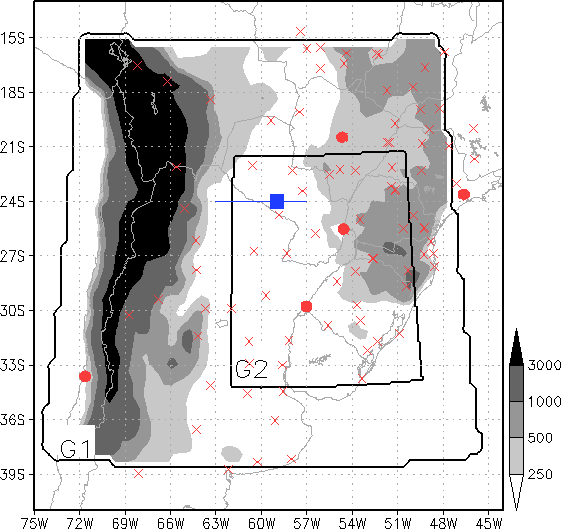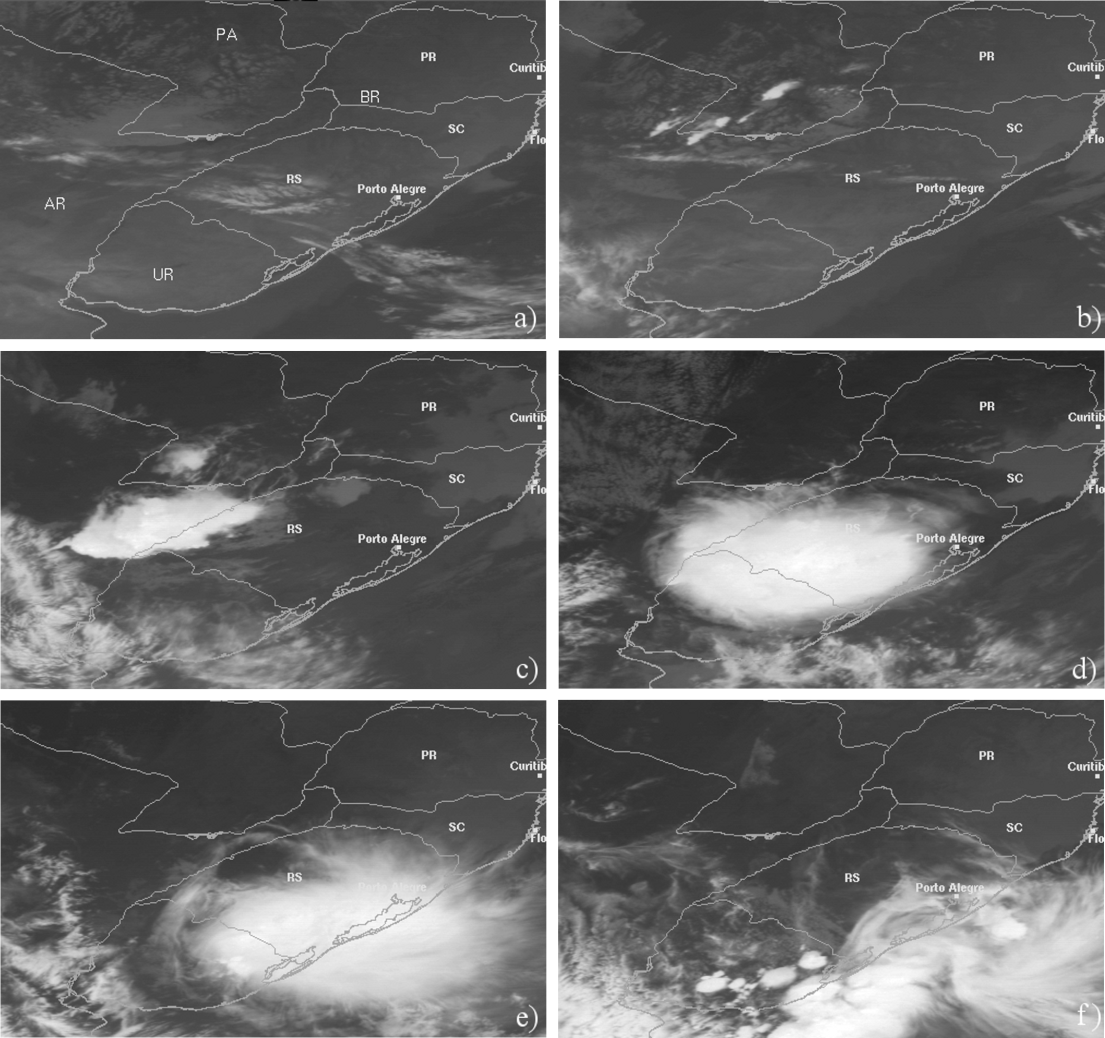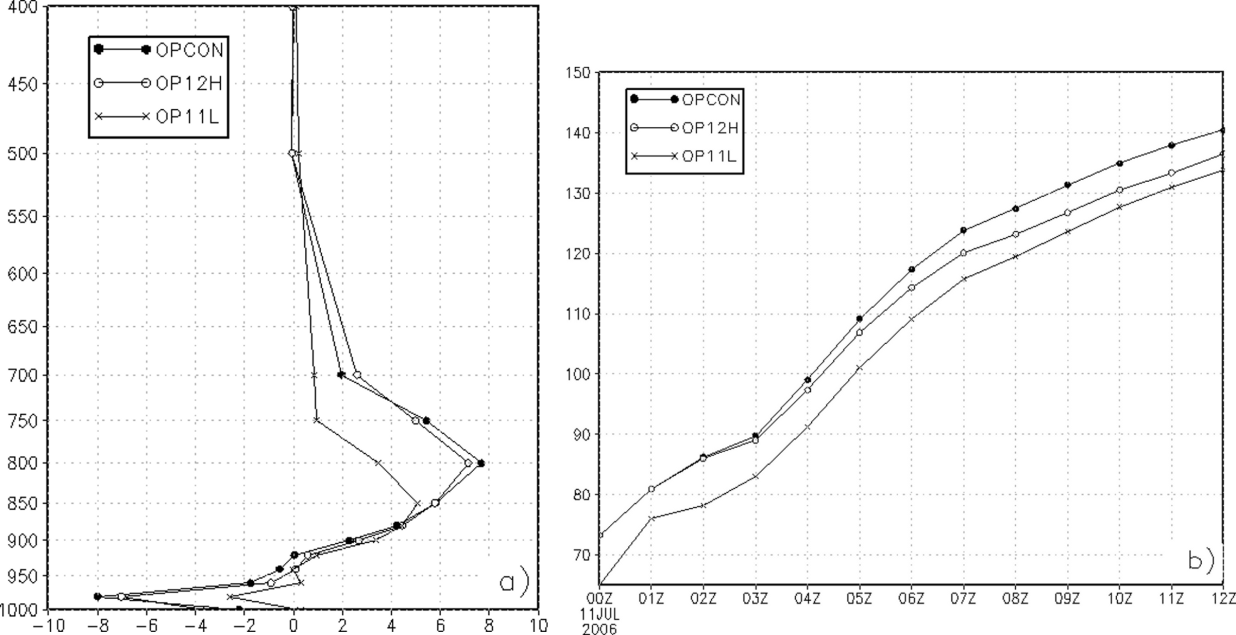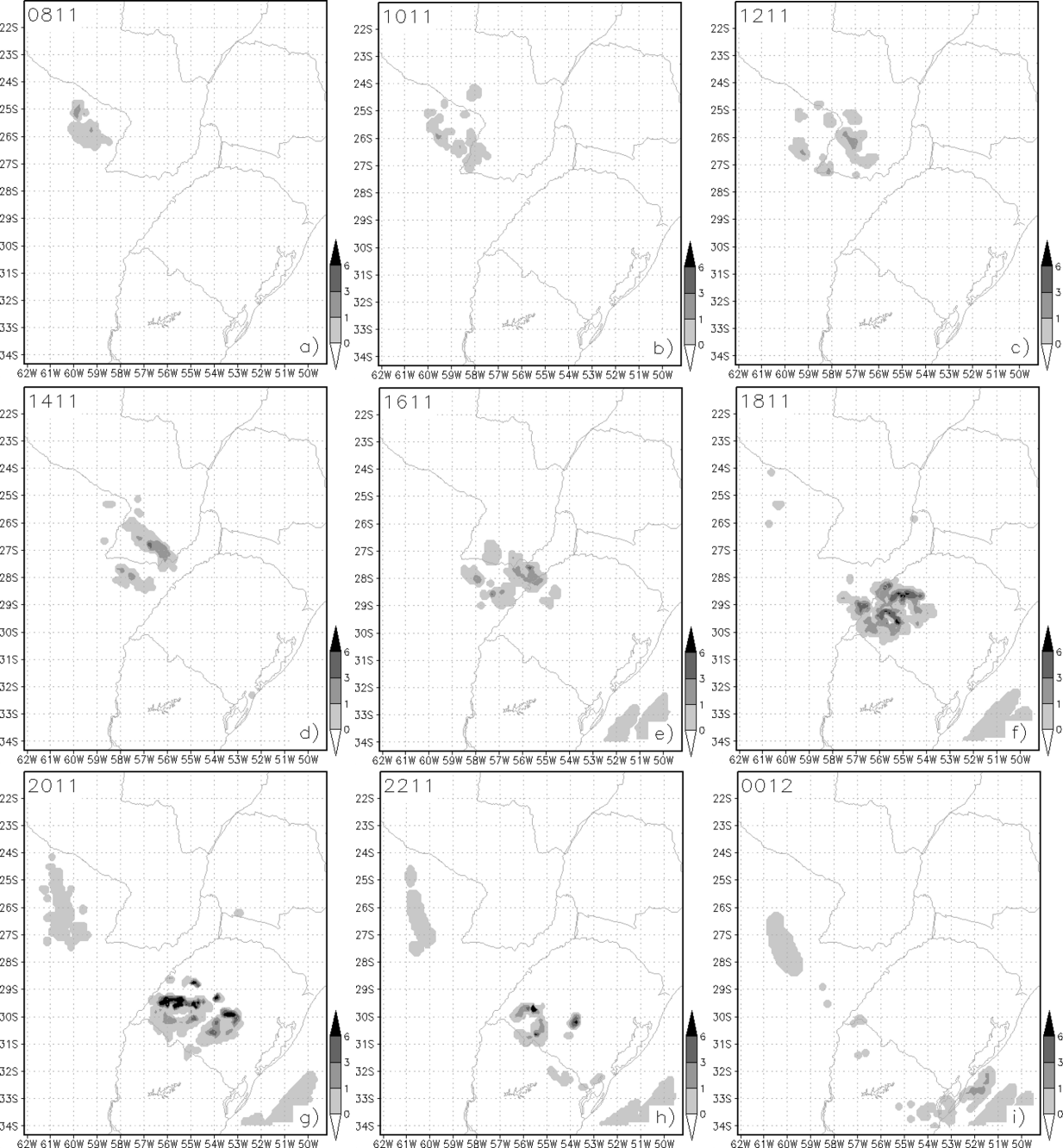-
Paper Information
- Next Paper
- Previous Paper
- Paper Submission
-
Journal Information
- About This Journal
- Editorial Board
- Current Issue
- Archive
- Author Guidelines
- Contact Us
American Journal of Environmental Engineering
p-ISSN: 2166-4633 e-ISSN: 2166-465X
2016; 6(4A): 84-93
doi:10.5923/s.ajee.201601.13

Numerical Simulations with a Mesoscale Convective Complex in South America
Everson Dal Piva1, Manoel Alonso Gan2, Vagner Anabor1, Franciano Scremin Puhales1
1Departamento de Física, Universidade Federal de Santa Maria, Santa Maria, Brazil
2Centro de Previsão de Tempo e Estudos Climáticos – Instituto Nacional de Pesquisas Espaciais, São José dos Campos, Brazil
Correspondence to: Everson Dal Piva, Departamento de Física, Universidade Federal de Santa Maria, Santa Maria, Brazil.
| Email: |  |
Copyright © 2016 Scientific & Academic Publishing. All Rights Reserved.
This work is licensed under the Creative Commons Attribution International License (CC BY).
http://creativecommons.org/licenses/by/4.0/

The development of a Mesoscale Convective Complex (MCC) over northeastern Argentina and southern Brazil from 11 to 12 July 2006 is analyzed because of the low skill of the operational forecasting of the Brazilian Regional Atmospheric Modeling System (BRAMS) for this event. The aim of this study is to identify the reasons for the low skill of the operational numerical forecast. For this purpose several experiments were run with the BRAMS using different: i) initial (with or without observations inclusion) and boundary (different level number and time increment of information) conditions; and ii) model configurations (number of grids, and convective parameterization closure). These experiments showed that the increase of levels number in the lower troposphere at 0600 UTC time (approximately 10 h before the MCC acquiring its circular shape) was essential for a better simulation of the precipitation associated with the MCC. In the experiments using analyses as initial and lateral conditions, the precipitation associated to the MCC do not develop or do so in a precarious way when the host model data has the vertical level number reduced or when the 0600 UTC analyses are suppressed (time omitted), respectively. Thus, to get a better operational forecasting of the MCC with BRAMS we suggest: i) a more appropriate model configuration (nesting grid with a 10 km horizontal resolution, and the convective parameterization closure type given by moisture convergence at atmospheric column); ii) a data assimilation scheme that includes 0000 UTC and 0600 UTC times; and iii) the host model data given by a larger number of vertical levels, mainly below 500 hPa.
Keywords: Precipitation, Modelling, Mesoscale convective complex
Cite this paper: Everson Dal Piva, Manoel Alonso Gan, Vagner Anabor, Franciano Scremin Puhales, Numerical Simulations with a Mesoscale Convective Complex in South America, American Journal of Environmental Engineering, Vol. 6 No. 4A, 2016, pp. 84-93. doi: 10.5923/s.ajee.201601.13.
Article Outline
1. Introduction
- One of the most important goals of operational forecasting is to predict the spatial and temporal characteristics of precipitation. Many socio-economic activities rely on precipitation knowledge, not only for lucrative or subsistence activities, but also to prevent natural disasters. Besides being an important variable, precipitation is also one of the most complex variables reproduced by numerical weather models. Microphysics and cumulus parameterization work together to produce precipitation in models of numerical weather prediction. In southern Brazil, the precipitation is evenly distributed throughout the year [12] and [13], but the weather systems that generate the precipitation are different each season. In the autumn and winter, the cold front passage, associated with extratropical cyclogenesis are more frequent [10] and [5]. In spring and summer seasons, the occurrence of Mesoscale Convective Systems (MCS, as squall lines, Mesoscale Convective Complex – MCC, and daytime convection) is more frequent [16], [8], [18] and [1]. Studying the MCC (and the MCS in general) is important because the middle latitude of South America has been identified as an intense activity area of MCS [16], [8], [18] and [1]. According to [16], the MCC observed over South America have very similar characteristics to those observed over North America. That is, they develop preferentially during the night, on a flat area and present strong relationship with low level jet, but on average they are 60% larger than the MCC observed in North America. More recently, [3] analyzed 330 events in nine warm seasons and confirmed that in South America the MCC are larger and longer than in North America. A good example of the difficulty of operational forecasting in predicting the correct precipitation distribution (spatial and temporal) generated by the MCC system can be seen in Figure 1. The MCC case hereinafter reported, developed between 11 and 12 July 2006 over the region between southern Paraguay, northern Argentina, Uruguay and southern Brazil. The observed accumulated rainfall showed two maxima, the most intense was located near 30°S-55°W and the other one, over the Brazil-Uruguay-Argentina border. Light rainfall was observed over Argentina and Uruguay. The operational forecasting (henceforth referred to as OPFOR) also showed two precipitation maxima, but they were positioned more to the northeast than the observed. The OPFOR just showed little precipitation over the northeast of Argentina and no rain over Uruguay. The secondary maximum of precipitation over the Brazil-Uruguay-Argentina border was not predicted by OPFOR. More details about the error in the precipitation operational forecasting, including the timing error, will be given in section 3.
 | Figure 1. Daily precipitation (mm) for 12 Jul for: (a) CPC analysis and (b) operational forecasting. Values of 1, 5, 15, and 30 mm are shaded |
2. Data and Methodology
- The dataset used in this study are: GOES-12 IR channel satellite picture from DSA-CPTEC/INPE; automatic weather station network from INMET, CPTEC, Companhia de Geração Térmica de Energia Elétrica (CGTEE), and Agência Nacional de Águas (ANA); radiosonde data obtained from the MASTER-IAG/USP; daily gridded precipitation analysis for South America produced by the Climate Prediction Center (CPC) with resolution of 1° latitude x 1° longitude; and rainfall estimated by algorithm 3B42RT from Tropical Rainfall Measuring Mission (TRMM), which have a resolution of 0.25° latitude x 0.25° longitude.For the initial condition and the host model three datasets were used: forecasting data form CPTEC/COLA Global Circulation Model (GCM), analysis from GCM (which is an analysis from the NCEP interpolated with GCM model grid) and analysis from GFS. The GFS analysis has horizontal resolution of 1° latitude x 1° longitude, 26 vertical levels and temporal resolution of 6 h. The horizontal resolution of the GCM analysis and forecasting is T126 (approximately 100 km), the vertical resolution is 14 levels and is available only at 0000 UTC and 1200 UTC for the analysis and each 6 h for the forecasting. The CPTEC/COLA GCM is a modified version of the spectral COLA GCM, which was adapted from NCEP GCM. The model used in the operational forecasting and in the simulations was the 3.2 version of the Brazilian Regional Atmospheric Modeling System (BRAMS), which is the 5.04 version of the RAMS (Regional Atmospheric Modeling System) tailored for the tropics [4]. The main characteristics are [2] and [11]: 1) Arakawa-C grid stagger; 2) vertical coordinate shaved “ETA”-type, with 36 levels, initial spacing of the 100 m, 1.1 of the stretch ratio and maximum stretch limited in 1000 m; 3) shallow cumulus parameterization with Grell scheme [6]; 4) bulk microphysics parameterization [17]; 5) Chen and Cotton long/short-wave model; 6) Smagorinsky deformation-K closure scheme; 7) soil/vegetation/snow parameterization with LEAF3 model; 8) lateral boundary conditions with Klemp and Wilhelmson radiactive condition; 9) weekly observed SST, interpolated from 1° latitude x 1° longitude resolution dataset; and 10) homogeneous soil moisture specified in 40%.All the experiments were run with BRAMS model, which is the RAMS adapted for the tropics. Nicolini et al. [9] showed that the RAMS is able to capture the strong forcing mechanism (low-level moisture convergence and upper-level divergence) favorable to organized convection, but it fails to produce enough precipitation or any precipitation at all. Figure 2 indicates the grid domains (Grid 1 – G1 and Grid 2- G2), and the orography used in the experiments. Grid 2 is used as a nesting of G1 and covers a large part of Paraguay, northeast of Argentina, Uruguay and the south of Brazil. The orography is characterized by the Andes Cordillera (with elevations over 3000 m) in the west part of the model domain and the Serra Geral (with elevations between 500 m and 1000 m) in the eastern part of the domain (Figure 2). A large area with elevations no more than 250 m is located between these two mountainous areas (Figure 2). It is important to remark that the MCC development area is characterized by low elevation and absence of deep slopes.
|
3. Results
- On the night of 10 July and the beginning of 11 July, a lower-level cloud area with temperature slightly lower than the land surface temperature was present over the north of Argentina and Paraguay (Figure not shown). These clouds moved southeastward, eventually located ending over the south of Paraguay and north Argentina at 0400 UTC 11 July (Figure 3a). At 0509 UTC 11 July these low clouds dissipated at the same time that convective cells developed (Figure not shown). These cells reached the maturity and dissipated at the same time that a new convective nucleus develops to the southwest as shown in Figure 3b-c. From this time on, the system acquired a circular shape (Figure 3d), displaced to the southeast (Figure 3e) and dissipated over the coastland (Figure 3f), where new nuclei developed firstly southeastward, over the east coast of South America and South Atlantic Ocean.
3.1. Spatial Precipitation Characteristics
- The OPFOR 3 h accumulated rainfall between 2100 UTC 11 July and 0000 UTC 12 July is presented in Figure 4a. In the previous nine hours (at 1200 UTC to 2100 UTC), the precipitation was not forecasted, i. e., the precipitation on 11 July was forecasted from 2100 UTC on. The misplacement of the precipitation forecast can be observed in Figure 4a, where the weather stations that recorded precipitation (closed circle) and stations that did not record (open circle) are indicated. The spatial characteristics of precipitation are also noted in the TRMM data (Figure 4b).
3.2. Numerical Simulations
- As previously shown the OPFOR forecasted no rainfall over the north of Argentina and also produced a little quantitative precipitation over Brazil-Uruguay border. On the other hand, the OPFOR generated the rainfall displacement northward (Figure 1b, 4a). Based on the OPFOR configuration, some experiments were made by changing the following characteristics: i) the initial condition, by inclusion of the surface observations and sounding data; ii) closure assumption type for convective parameterization; and iii) soil moisture; but in neither change the precipitation associated to the MCC was simulated. Figure 5 shows the accumulated rainfall between 0000 UTC 11 July and 0000 UTC 12 July for some of the Table 1 experiments. In the OPGCM experiment, the model configuration was the same as in the OPFOR experiment, but with the host model given by GCM analysis each 12 h (0000 UTC and 1200 UTC times). Although the boundary condition was exchanged from forecasting to analysis (considered as “perfect” forecasting) data, the precipitation associated to the MCC continued not being simulated (Figure not shown) and the CSI remains small (CSI = 0.06 and 0.09, Table 1). The same happened with the closure assumption type change or with the horizontal resolution increase due to the second grid inclusion. Another experiment was conducted by changing the host model data (OPCON experiment). The OPCON experiment has the same OPFOR model configuration but the host model data are given by GFS analysis each 6 h. This simulation was able to start the convection over the south of Paraguay and north of Argentina and its posterior displacement to southeast over the extreme south of Brazil (Figure 5a) as seen in satellite pictures (Figure 3). Although the experiment simulated the precipitation associated to the MCC, it can be seen that the rainfall rate was lower than the observed. Also, the simulation trends displace the strongest precipitation to the north, without intense precipitation over the triple border Brazil-Uruguay-Argentina and Uruguay. The improvement of the precipitation pattern can be noted by the CSI which increased from 0.29 (for OPFOR) to 0.37 (for OPCON) for TRMM dataset (Table 1). Albeit the GFS data having a horizontal resolution similar to the GCM data, the GFS data have more vertical levels and are available every 6 h. The question placed is what defines the simulation of the precipitation associated to the MCC: the finer vertical resolution, the finer time resolution, or both?
 | Figure 7. Difference of the vapor mixing ratio at 2 m above ground  between analysis plus observation and analysis only at 0000 UTC 11 Jul between analysis plus observation and analysis only at 0000 UTC 11 Jul |
4. Conclusions
- In this study the reason why a MCC case was not very well forecasted with an operational forecasting system is analysed. The MCC formation occurred over southern Paraguay and northern Argentina around 0600 UTC 11 July 2006 and displaced southeastward in direction of the extreme south of Brazil, generating intense precipitation over the region. To determine why the skill of the numerical precipitation forecast was low, a set of experiments with some changes in the operational forecasting configuration were realized. The modifications were: i) the host model data, and ii) model configuration.From the experiments performed, it can be concluded that a better temporal and vertical resolution is essential to simulate the precipitation associated to the MCC resided in the GFS data. Thus the inclusion of the analysis at 0600 UTC 11 July, even though there was no SYNOP data over Brazil but with surface data over Argentina and Paraguay, which covered a large part of the initial the MCC development area. It is noteworthy that using the GFS analysis as host model and excluding the analysis at 0600 UTC 11 July, the development of precipitation associated to the MCC was not very well forecasted. The same happened when the vertical level number was reduced in the GFS data. Thus, it supposed that the OPFOR was dominated by the moisture convergence area established throughout the latitude of 27oS located over the northeast of Argentina and the south of Brazil at 0000 UTC 11 July (in initial condition), generating intense precipitation dislocated northward, which does not allow the MCC formation at 0600 UTC 11 July. Meanwhile in the observation analysis there was an established intense moisture convergence area located over the Paraguay and Argentina border.With the GFS analysis as the host model and using the operational forecasting model configuration it was possible to simulate the precipitation associated to the MCC; however, the accumulated precipitation located northward of the observation data was inferior to the observed one. In this way, the simulations were carried out with some modifications in the model configuration to displace the accumulated precipitation southward. The configuration of the best results was as follows: i) two grids, the first one with 40 km and the second with a 10 km horizontal resolution; ii) inclusion of surface weather station and radiosonde observations to improve the initial condition at 0000 UTC 11 July; and iii) exchange of convective parameterization closure type to moisture convergence. With these configurations, it was possible to simulate higher quantity of precipitation displaced to the Brazil-Uruguay border, and with the intense precipitation over the extreme south of Brazil. Although the simulated precipitation was greater, the intensity was still smaller than the observed. The secondary accumulated precipitation maximum over the triple Brazil-Uruguay-Argentina border was not simulated by any experiment realized.Finally, it can be concluded that for this specific case, it might be possible to get an acceptable operational forecast of the MCC through: i) from a more appropriate model configuration; ii) an assimilation data scheme that include the observation data of 0000 UTC and 0600 UTC times; and iii) with a host model provided with more vertical level number, mainly below 500 hPa level. The optimal configuration should have the following characteristics: i) two grids, the first with 40 km and the second with 10 km; and ii) the deep convective parameterization closure assumption based on the moisture convergence at atmospheric column.
ACKNOWLEDGEMENTS
- The research reported in this paper was carried out with the support of CAPES (Project 7920) and CNPq (Project 381246/2007-8), entities of the Brazilian Government directed toward the formation of human resources and scientific and technological research. Thanks to DSA-CPTEC/INPE, INMET, MASTER-IAG/USP, CGTEE, for allowing free download of all dataset used in this study.
 Abstract
Abstract Reference
Reference Full-Text PDF
Full-Text PDF Full-text HTML
Full-text HTML





 in 24°S and 59°W (closed blue square in Figure 2) at 0600 UTC 11 Jul (a) and moisture flow
in 24°S and 59°W (closed blue square in Figure 2) at 0600 UTC 11 Jul (a) and moisture flow  vertically integrated (from 1000 hPa to 700 hPa) over the latitude of 24°S, form 63°W to 57°W of longitude (blue line in Figure 2) to: OPCON (closed circle), OP12H (open circle) and OP11L (closed square) experiments
vertically integrated (from 1000 hPa to 700 hPa) over the latitude of 24°S, form 63°W to 57°W of longitude (blue line in Figure 2) to: OPCON (closed circle), OP12H (open circle) and OP11L (closed square) experiments
 , gray scale) in 2GMCO experiment for grid 2, began at 0800 UTC 11 Jul (a) and ended at 0000 UTC 12 Jul (i), at intervals of 2 h. The values between 0, 1, 3 e 6
, gray scale) in 2GMCO experiment for grid 2, began at 0800 UTC 11 Jul (a) and ended at 0000 UTC 12 Jul (i), at intervals of 2 h. The values between 0, 1, 3 e 6  are shaded. The numbers in the upper left corner indicate the hour and day of Jul 2006. For example, 0811 indicates the 0800 UTC 11 Jul
are shaded. The numbers in the upper left corner indicate the hour and day of Jul 2006. For example, 0811 indicates the 0800 UTC 11 Jul